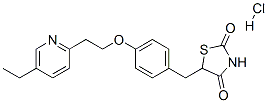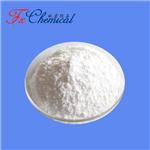Description
Pioglitazone is a new orally active thiazolidinedione (TZD) launched in the US for the treatment of non-insulin dependent diabetes mellitus
(NIDDM). It can be synthesized in 4 steps, the last one transforming an alphabromoester
into thiazolidine with thiourea. As with other representatives in this
class, it potently activates the nuclear receptor peroxisome proliferator-activated
receptor gamma which is believed to be involved in the regulation of insulin
resistance and adipogenesis. In several obese and obese diabetic animal
models, treatment with Pioglitazone resulted in reductions in plasma glucose
and serum lipids. In clinical studies, Pioglitazone at a once daily oral dose of 15-45 mg, as monotherapy or in combination with non-TZDs or insulin, was shown
to significantly improve glycemic control in type-2 diabetes and demonstrated a
beneficial effect on insulin resistance and other clinically relevant parameters as
plasma levels of triglycerides or HDL-cholesterol. Pioglitazone is reported to be
safe and well tolerated and is said to have a lower occurrence of hepatic toxicity
as well as a low probability for drug interaction.
Manufacturing Process
To a solution of 2-(5-ethyl-2-pyridyl)ethanol (53.0 g) and 4-fluoronitrobenzene (47.0 g) in DMF (500 ml) was added portionwise under ice-cooling 60% sodium hydride in oil (16.0 g). The mixture was stirred under ice-cooling for one hour, then at room temperature for 30 min, poured into water and extracted with ether. The ether layer was washed with water and dried (MgSO4). The solvent was evaporated off to give 4-[2-(5-ethyl-2pyridyl)ethoxy]nitrobenzene as crystals (62.0 g, 62.9%). Recrystallization from ether-hexane gave colorless prisms, melting point 53°-54°C.
A solution of 4-[2-(5-ethyl-2-pyridyl)ethoxy]nitrobenzene (60.0 g) in methanol (500 ml) was hydrogenated at room temperature under one atmospheric pressure in the presence of 10% Pd-C (50% wet, 6.0 g). The catalyst was removed by filtration and the filtrate was concentrated under reduced pressure. The residual oil was dissolved in acetone (500 ml)methanol (200 ml). To the solution was added a 47% HBr aqueous solution (152 g). The mixture was cooled, to which was added dropwise a solution of NaNO2 (17.3 g) in water (30 ml) at a temperature not higher than 5°C. The whole mixture was stirred at 5°C for 20 min, then methyl acrylate (112 g) was added thereto and the temperature was raised to 38°C. Cuprous oxide (2.0 g) was added to the mixture in small portions with vigorous stirring. The reaction mixture was stirred until nitrogen gas evolution ceased, and was concentrated under reduced pressure. The concentrate was made alkaline with concentrated aqueous ammonia, and extracted with ethyl acetate. The ethyl acetate layer was washed with water and dried (MgSO4) The solvent was evaporated off to leave methyl 2-bromo-3-{4-[2-(5-ethyl-2pyridyl)ethoxy]phenyl}propionate as a crude oil (74.09 g, 85.7%).
A mixture of the crude oil of methyl 2-bromo-3-{4-[2-(5-ethyl-2pyridyl)ethoxy]phenyl}propionate (73.0 g) thiourea (14.2 g), sodium acetate (15.3 g) and ethanol (500 ml) was stirred for 3 hours under reflux. The reaction mixture was concentrated under reduced pressure, and the concentrate was neutralized with a saturated aqueous solution of sodium hydrogencarbonate, to which were added water (200 ml) and ether (100 ml). The whole mixture was stirred for 10 min to yield 5-{4-[2-(5-ethyl-2pyridyl)ethoxy]benzyl}-2-imino-4-thiazolidinone as crystals (0.3 g, 523.0%). Recrystallization from methanol gave colorless prisms, melting point 187°188°C, dec.
A solution of 5-{4-[2-(5-ethyl-2-pyridyl)ethoxy]benzyl}-2-imino-4thiazolidinone (23.5 g) in 2 N HCl (200 ml) was refluxed for 6 hours. The solvent was evaporated off under reduced pressure, and the residue was neutralized with a saturated aqueous solution of sodium hydrogencarbonate. The crystals (23.5 g, 97.5%) which precipitated were collected by filtrationand recrystallized from DMF-H2O to give 5-{4-[2-(5-ethyl-2pyridyl)ethoxy]benzyl}-2,4-thiazolidinedione as colorless needles (20.5 g, 86.9%), melting point 183°-184°C.
In practice it is usually used as hydrochloride salt.
References
1) Merck 14:7452
2) Sakamoto et al. (2000), Activation of human peroxisome proliferator-activated receptor (PPAR) subtypes by pioglitazone; Biochem. Biophys. Res. Commun., 278 704
3) Wilson et al. (2000), The PPARs: From Orphan Receptors to Drug Discovery; J. Med. Chem., 43 527
4) Shannon et al. (2017), Pioglitazone Inhibits Mitochondrial Pyruvate Metabolism and Glucose Production in Hepatocytes; FEBS J., 284 451
5) Zhao et al. (2016), The Antidepressant-Like Effects of Pioglitazone in a Chronic Mild Stress Mouse Model Are Associated With PPARγ-Mediated Alteration of Microglial Activation Phenotypes; Neuroinflamm., 13 259




